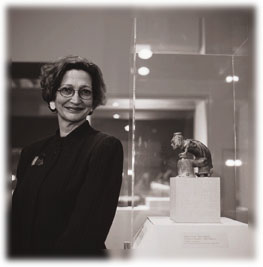Main Menu · Search ·Current Issue ·Contact ·Archives ·Centennial ·Letters to the Editor ·FAQs

 Program participant Susana Leval, director of El Museo del Barrio. MARC ROYCE
Program participant Susana Leval, director of El Museo del Barrio. MARC ROYCE |
SCULPTING THE FUTURE
When a city bond enabled the San Francisco Asian Art Museum to relocate to a 1917 Beaux Arts building, the museum's director, Emily Sano, got more than a classical loggia and barrel-vaulted ceilings. She also inherited 14 California landscapes painted by turn-of-the-century artist Gottardo Piazzoni. Unfortunately, these entryway murals make an odd welcome to a museum of Asian art. But when the museum board suggested moving them elsewhere, local conservationists created a furor, calling on Sano to preserve the murals in their intended architectural site.
The fate of the landscapes remains unsettled, but the controversy exemplifies the many complex issues museum directors face in the 1990s. Today's museum heads must master a range of fields, including finance, business management, marketing, and politics. Traditionally, directors have risen from the ranks of curators, but a curator's training in connoisseurship does not provide the comprehensive background required to run a large organization. Recognizing this problem, an anonymous donor has provided Harvard with both the inspiration and the funding to train young museum directors. Experience on several museum search committees had convinced the donor not only that many candidates were inadequately prepared for a director's job, but also that the talent pool was woefully shallow.
This past fall, professor of fine arts James Cuno, director of the Harvard University Art Museums, and James Wood, director of the Art Institute of Chicago, launched the pilot session of the new program, which brings four young museum directors together with four more senior directors three times a year at Harvard for up to a week of seminars, discussions, and workshops. "The feedback has already been very positive," according to Mimi Gaudieri, executive director of the Association of Art Museum Directors.
Harvard has a long tradition of educating museum professionals. The current directors of the Metropolitan Museum of Art and the Museum of Modern Art in New York City, the National Gallery of Art in Washington, D.C., the Philadelphia Museum of Art, and the St. Louis Art Museum all hold Harvard degrees. And during the 1930s, the late Paul Sachs, then professor of fine arts and associate director of the Fogg Art Museum, offered the country's first courses in museumship. But the priority then was building collections, so Sachs's course emphasized connoisseurship. Today, Cuno says, the focus is quite different.
Museum culture dates as far back as the Renaissance, when the early, privately owned museums were sometimes called "wonder cabinets." But in the United States, the oldest municipal public art museums date only from the 1870s. The expanded role that museums play in late twentieth-century culture has changed and enlarged the responsibilities of their directors. David Levy, director of the Corcoran Gallery of Art in Washington, D.C., likens the urban museum to "the contemporary version of a medieval cathedral, a place where lots of things happen. People come to a lecture, come to eat lunch, to get married."
Modern museum directors may face engineering issues, such as determining the appropriate structural renovations needed to protect art objects from earthquake damage at the future site of the San Francisco Asian Art Museum. They may also face political issues. Susana Leval, who heads New York's El Museo del Barrio, must answer groups who charge her museum with "ghettoizing" Latin American artists by isolating their work in a culturally specific museum. In a diverse urban community, a museum like Leval's must represent constituencies ranging from Caribbean pre-Columbian cultures to contemporary American-born artists of Latino descent--all of them competing for limited resources of exhibition space, time, and funds.
The new Harvard program addresses such real-world challenges with nuts-and-bolts training and theoretical debates. Last fall's session focused on leadership, drawing on the expertise of Harvard faculty members in business, education, and law. At this spring's meeting, participants are scheduled to complete the Business School's executive-education program on strategic perspectives for nonprofit management (see "What Is the Competition for Homelessness?" July-August 1997, page 66). The third session will consider political, social, and cultural pressures affecting museums.
"Our country's museums are under tremendous pressure socially, financially, and artistically," says Cuno. "At a time when art itself is being attacked as extraneous to the life of our nation, we need to develop strong voices in favor of art and strong leaders to direct our art museums. We expect our program to help."
~ Nancy Staab